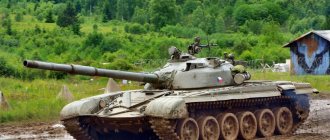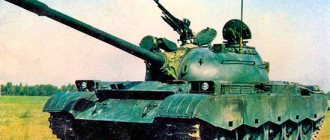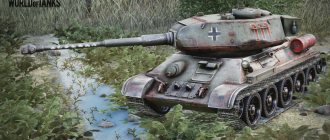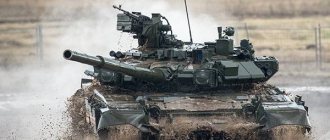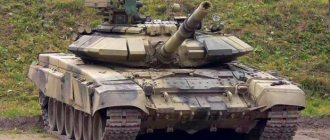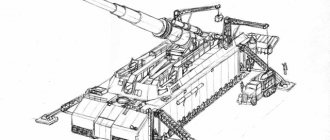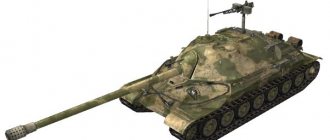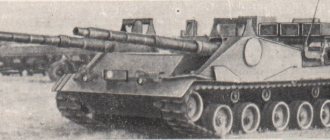T14 is an American Tier V premium tank. It can be purchased in the store for 2400 gold. Sometimes it can be included in various sets as an “add-on”.
The main advantage of the T14 is its rapid-fire cannon. As a premium tank, it has increased profitability. What made it special was its sides. Thanks to powerful armor, the tank is able to withstand even opponents of a higher level. However, the specifics of its use and the demanding tactics often lead to players simply getting lost and not realizing the potential of the technique. In this guide you will learn about all the features of this tank.
Win more often! Install World of Tanks: Blitz on PC with BlueStacks and enjoy convenient tank control with comfortable aiming!
History of the creation of T14
From May 1942 to May 1943, using structural components and assemblies of the M6 and M4, the development of a new heavy tank T14 was underway within the framework of cooperation between Great Britain and the United States. The British needed a powerful tool suitable for covering infantry on the battlefield to replace the gradually becoming obsolete Churchills. The new tank was distinguished by powerful frontal armor, and it was planned to install a 75-mm gun as an armament. A total of two prototypes were built.
Weak armament, problems with suspension and tracks led to delays in the development of the project until 1944, when it became clear to the customer, Great Britain, that the current model of the tank no longer met the requirements. Priorities were changed in favor of cruiser tanks, which had more serious armament, and the T14 was unable to reach the production stage. Already in December 1944, all work on the project was stopped.
There is no analogue in the world
The Armata is one of the most advanced tanks in the world, if not the most advanced. The T-14 not only surpasses all analogues available in the world, Leonkov notes. All tanks in the world are decades behind the Armata.
“It’s not surprising. A tank building industry comparable to the Russian one cannot be built out of the blue. Only Germans and, in extreme cases, Americans can afford this. However, they did not do this. In recent decades, tank building in Germany and the USA has been at zero. Both the Germans and the Americans are now not creating new models, but are only modernizing - bringing to the modern level - existing ones. “Armata” is a completely new development,” said a military analyst in a conversation with a correspondent of the Federal News Agency .
kremlin.ru / Press service of the President of Russia
In appearance, the T-14 is not very different from other Russian tanks that rolled off assembly lines in the last decades of the 20th century, however, the latest ideas and technologies were used in its creation. “This applies to both crew protection and the fire guidance system. Even its uninhabited tower with heavy weapons installed on it has no analogues in the world,” adds Alexey Leonkov.
“Let's look at the American military industry for comparison. Even Abrams tanks stopped being produced in the United States in 2007. Their Detroit production plant is closed. Only enterprises are working to modernize existing Abrams. They are equipped with new dynamic active protection systems and new sighting systems, but in reality all this is already an outdated product. The turret, tracks and engines are the same. Even the armor on the Abrams is outdated,” the expert sums up his position.
Characteristics
In the table you can view the main characteristics of the tank:
| Strength, units | 750 |
| Damage, units | 160 |
| Rate of fire, vs/m | 9,6 |
| Armor penetration, mm | 106 |
| Reservation, mm | 53 |
| Speed, km/h | 34 |
| Rotation, deg/s | 23 |
It may seem that the T14 has weak armor, but this is only true for the frontal projection. When a tank is standing directly in front of its enemy, it will not be difficult to penetrate it. The sides are shielded, which provides protection from rare cumulative projectiles, and rational angles of inclination bring the reduced armor to 200-250 mm when rotated 25-30 degrees relative to the enemy.
The main weak point of the tank is its gun. 106 mm of armor penetration is not enough for Tier V, while sub-caliber shells penetrate only 127 mm, which is why the T14 is unable to fight on equal terms against Tier VI heavy tanks and even most medium ones. You must engage in containing the enemy in a fortified position. And also remember that in the turret, taking into account the given armor, you only have 130 mm. And they will break through there most often.
What is the superiority of the T-14 Armata tank gun?
One of the main features of the new T-14 Armata tank is its uninhabited turret. That is, the crew of this vehicle is located in a special armored capsule located in the tank body. This makes it possible for tankers to survive any chemical attack and even a nuclear explosion. In addition, this innovation made it possible to rid the combat vehicle of the presence of a powder gas ejector, as well as the need to purge the barrel after each shot, which had a positive effect on the rate of fire of the new weapon.
According to official data, the new Armata tank has the ability to conduct targeted fire at the enemy at a distance of 3.5 kilometers, as well as capture a target within a radius of up to 7 kilometers. The new 2A82 cannon is controlled remotely and can conduct targeted fire at both ground and air targets.
Before the appearance of the Armata, the 120-mm Rh120 L/55 gun, which was installed on the German Leopards and American Abrams, was considered the best gun in the world. However, the 2A82 gun completely eclipsed all its competitors. After all, the muzzle energy of this gun is 1.17 times higher than that of all its analogues, and the remaining technical characteristics of this gun are exceeded on average by 1.2-1.25 times.
It is also worth noting that the 2A82 modification cannon is capable of firing both existing 125-mm shells and new ammunition. Namely:
- armor-piercing sub-caliber projectiles 3BM59 "Svinets-1" and 3BM60 "Svinets-2" with a length of 740 millimeters, as well as 900-mm projectiles of the new type "Vacuum-1" and "Vacuum-2"
- 3UBK21 "Sprinter" missiles with an effective range of up to 8 kilometers
- shrapnel fragmentation shells called “Telnik”, capable of remote detonation at any point in the trajectory
Conclusion
To summarize, it is worth saying that at the moment the Russian T-14 Armata tank is a real breakthrough in modern tank building. After all, there are no analogues of this combat vehicle in the world, and most likely there will not be for a long time. Thus, during its existence, “Armata” was constantly modernized, which made it possible to deprive this combat vehicle of existing “childhood diseases”.
As for the combat power of this new product, the 125-mm 2A82 cannon also has significant advantages over the armament of all modern tanks, surpassing all its analogues in rate of fire, range and efficiency.
And if we talk about the 152-mm 2A83 gun, which the Armata can also be equipped with, then no other country in the world has such developments. After all, absolutely all tanks of NATO countries use exclusively 120-caliber shells. And all developments of tanks with 140 mm guns are currently either closed or frozen. Therefore, in this direction, Armata has absolutely no competitors.
Tank T-14 "Armata".
A sample of the 125-mm 2A82 tank gun developed by JSC Plant No. 9 at a test site.
125-mm tank gun 2A82 for the Armata.
Comparative characteristics with analogues.
Tank T-14 "Armata" with a 152 mm 2A83 gun.
edit this post
Game tactics
T14 can be played in two ways: through the diamond or from cover.
Diamonding
Positioning the tank in a diamond shape in relation to the enemy at 15-30 degrees is a basic technique that any WoT Blitz player should know. The idea is to position the tank at an angle. This increases the level of armor given and allows you to deflect projectiles.
When moving through open areas, the T14 is very vulnerable. The diamond is the only chance to survive. Experienced players monitor the movement of the enemy gun and adjust the hull accordingly. In some cases, it makes sense to “wiggle” the body left and right - an enemy shot can go into the caterpillar without damage. The tactic only works against enemies of a lower level. The rest are capable of confidently hitting the T14 in the frontal part of the turret or hull, regardless of the angle of impact.
If it comes to a “collision of heads”, try to “get in” close to the enemy side and start driving back and forth, knocking down his aim. If the enemy is higher, he won't even be able to hit.
From cover
The tactic is similar to diamond formation, but you will need some large cover. A stone, a building, a fold in the terrain - all of this will work perfectly. Most players are impatient and can be caught in this. It is worth driving up close to the shelter and starting to back up, driving towards the enemy so that he sees the side at a right angle. An experienced enemy will know that it will not be possible to penetrate the side, and will try to target the turret. Anticipate it! Show a piece of the tower, and then sharply move forward and thereby dodge the projectile.
This tactic may not be suitable for beginners, as it requires some experience and understanding of how the enemy will act. But it’s worth trying and trying, in the end it will yield results. You can use this tactic at any distance, both close and ranged. But keep in mind that as the distance increases, the already weak penetration becomes even smaller.
Medium attack aircraft for the British
When the British mission arrived in the United States at the end of 1940, it hoped to organize the production of British tanks in American factories. The situation of the First World War was to be repeated, when the United States produced weapons of British and French design. But over the past twenty years, the United States has become a powerful industrial power that could create military equipment that is at least as good as that of England. For this reason, the idea of producing British tanks in the USA was abandoned. However, this did not stop the Americans from releasing Grant I, the English version of the American Medium Tank M3. At the request of the British, specialized assault tanks were also developed. We talk about Assault Tank T14
, and also figure out what
the A33 Excelsior
.
Excelsior alternative
As you know, the British had three types of tanks during the war: light, cruising and infantry. Light tanks quickly stopped being produced. The cruising vehicles were distinguished by high mobility, but their level of protection turned out to be modest, as a result they were vulnerable to fire from anti-tank guns of even small calibers (37-50 mm). Infantry tanks were their complete opposite - they put defense at the forefront, sacrificing mobility. In fact, infantry tanks were created for battlefields like those of the First World War.
The fighting in France showed that the concept of an infantry tank was largely erroneous. The Germans quickly found control over both the Infantry Tank Mk.I and the more successful Infantry Tank Mk.II. The second tank, better known as the Matilda, was rehabilitated at the end of 1940 during Operation Compass, where these vehicles operated with almost impunity. The luck ran out by the summer of 1941, when full-fledged combat operations against the Afrika Korps began. It was not only a matter of better training of the German army, but also more advanced anti-tank weapons. Infantry tanks, which had an average speed of 20-25 km/h, turned out to be an excellent target in open areas. This was the same for the Valentine infantry tanks, whose combat debut took place in the second half of 1941.
The A33 Excelsior assault tank, which was the English equivalent of the T14. The first prototype of the car had the same chassis as the T14.
Of course, the British military did not sit idly by. Analyzing the results of combat operations, they came to the conclusion that one of the significant disadvantages of infantry tanks is their low mobility. Of course, the production of infantry tanks did not stop; moreover, the production of a third, heavy type of infantry tank, the Churchill, began. Nevertheless, work began on creating an alternative, assault tank. This vehicle was supposed to combine the best qualities of a cruising and infantry tank: thick armor and high mobility. It is not surprising that, given such requests, they decided to take the newest cruising tank as a basis - the A27, better known as the Cromwell.
During 1941-1942, several assault tanks based on the Cromwell were proposed. As a result, the A33 project, developed by English Electric, was recognized as the best. This particular machine, better known as the Excelsior, was made in metal. It is interesting that already at this stage there was American participation. The fact is that the A33 was supposed to use the suspension and tracks from the American Heavy Tank T1, better known as the Heavy Tank M6. In addition to the already proven design, the use of the T1 suspension was unification with the vehicle that the British planned to receive under the Lend-Lease program.
The first prototype of the Assault Tank T14. ALCo plant, summer 1943.
The use of elements of the Heavy Tank T1 chassis was only the beginning of Anglo-American cooperation in the line of assault tanks. At the beginning of 1942, negotiations began between the British Tank Mission and the American Armaments Committee, their goal was to test the waters for the joint development of an assault tank in the United States. The reason for this was that the British military decided to play it safe. They had more than enough reasons for such a decision: the A27 program was already stalled, let alone the assault tank based on it. In addition, the capabilities of the British tank industry were not limitless, and the Americans would hardly have agreed to produce a British-designed tank.
As a result, the idea arose of creating a direct analogue of the A33, but based on the American Medium Tank M4. Unlike the Medium Tank M3, this vehicle already had weapons in the turret, and in terms of the total characteristics of the M4 it was superior to any English tanks. On March 30, 1942, a meeting was held with the participation of representatives of the British Tank Mission, the Aberdeen Proving Ground and the Armament Committee. During it, a final decision was made on the development of an assault tank. Two prototypes of the A33 and its American counterpart were produced, after which they underwent extensive testing. As a result, the British chose the car that suited them best.
Heavy tank from medium
The development of the American analogue of the A33 fell on the shoulders of the employees of the Aberdeen Proving Ground. In May 1942, the Armaments Committee assigned this development the designation Assault Tank T14. It is worth noting that this task was not easy. The increase in combat weight meant that the Medium Tank M4 chassis could not be used in its previous form. None of the available engines were suitable in their pure form, since not only armor was required, but also mobility. According to the specification, the maximum speed was 24 miles per hour (about 38.5 km/h), and the protection requirements implied an increase in combat weight by about 15 tons. In short, the Medium Tank M4 base needed to be seriously reworked.
The tank turned out to be significantly lower than the Medium Tank M4. The overall height of the T14 was just under 2.5 m.
The preliminary design of the Assault Tank T14 was prepared by the Aberdeen Proving Ground in June 1942. The original version of the vehicle featured a suspension with leaf springs, while the bogies themselves were more reminiscent of the Medium Tank M4. The most suitable engine was considered to be the Ford GAA, which was installed on the Medium Tank M4A3. However, its power was not enough, so it was proposed to use a boosted one up to 520 hp. variant designated Ford GAZ. The Aberdeen Proving Ground also proposed replacing the engine with a V12 in the future (at that time there were no such engines).
The transmission remained from the M4, but it was redesigned to accommodate the higher engine power and greater combat weight of the vehicle. The body of the vehicle and its turret changed significantly. If in the case of the A33 the basic Cromwell hull was taken as a basis, and its armor was strengthened, then the American designers acted differently. The T14 body is longer, lower and wider. In fact, it was a new tank based on the Medium Tank M4 units. Also, American engineers approached the issue of strengthening protection more rationally. Instead of simply “hanging” excess mass, in some cases armor was strengthened through rational angles of inclination of the armor. Leaving the thickness of the upper frontal hull plate the same as that of a regular M4 (51 mm), the vertical tilt angle was increased to 60 degrees from the vertical. A significant increase in mass occurred due to increased protection of the sides of the hull. The upper side sheets were strengthened to 51 mm and tilted 30 degrees from the vertical, and the chassis was also covered with side screens. As a result, the total thickness of the sides reached 76 mm. The thickest part of the body was the transmission unit casing - 102 mm. The ball mounting of the directional machine gun, the hatches of the control compartment, as well as the engine compartment have changed significantly.
In the final version, the T14 tracks and road wheels were taken from the Heavy Tank M6.
The metamorphoses of the tower also turned out to be very significant. While maintaining the already large diameter of the turret ring, the T14’s “head” has become larger. This was the result of both increased protection (from 76 to 102 mm) and some uncertainty with weapons. It was originally planned that the tank would receive a 75 mm M3 cannon, but already in July 1942, an alternative weapon option appeared in the form of a 105 mm howitzer. Moreover, among the potential weapon options, a 90-mm gun with anti-aircraft ballistics was also considered. Ideas for alternative guns for the T14 did not progress further than projects; however, the turret was made larger, which also led to an increase in combat weight.
The tank was powered by a 520-horsepower Frd GAZ engine (a supercharged version of the Ford GAV).
The extent to which the British were interested in the Assault Tank T14 is evidenced by a simple fact: in May 1942, there was talk of a potential supply of 8,500 such tanks under Lend-Lease. At the same time, the American military looked at this tank with skepticism - in their opinion, the US Army did not need such a vehicle. Thus, the Assault Tank T14 was created exclusively for the English side. At the same time, the design of the vehicle changed as development progressed; the T14 was finally approved in April 1943. Over the past time, the chassis has changed a lot - the road wheels and suspension, as well as the tracks, were borrowed from the Heavy Tank M6 (in documents it is called T1). Instead of the Browning M2HB machine gun, they took the more familiar M1919A4, and the machine gun was equipped with a sight, which was not installed on American tanks. The anti-aircraft machine gun was also changed to the Browning M1919A4. The approach to the method of manufacturing hulls also changed - prototypes received welded hulls, while production vehicles had to receive cast ones.
Failed boost
Beginning in June 1942, Aberdeen Proving Ground did not work alone on the Assault Tank T14. Locomotive builders from ALCo (American Locomotive Company) acted as the contractor for the production of the machine. For them, this became a completely core job: the production of the Medium Tank M4A2 was organized at ALCo facilities, the first vehicles were delivered in September 1942. The finalization of the project also fell on the shoulders of the manufacturers. Due to various changes made to the T14 project, ALCo was able to begin production of pilot samples only closer to the beginning of the summer of 1943. It must be said that things did not go quickly with the A33 - the first sample of the tank was assembled by English Electric only on November 11, 1943, that is, almost six months later.
The first prototype of the Assault Tank T14 at Aberdeen Proving Ground, 2 August 1943.
In the final version, the combat weight of the Assault Tank T14 was a little more than 42.6 tons. This was 2 tons more than the A33, but we must take into account that the “source” of the English tank was 3 tons lighter. The specific power of the machine was 12.2 hp. per ton - taking into account the significant increase in protection, this is a completely acceptable result. The ammunition capacity turned out to be slightly less than that of the Medium Tank M4 - 90 rounds of 75 mm caliber and 9000 rounds of rifle caliber. Also in the roof of the tower there was an English 51-mm breech-loading mortar (ammunition capacity - 12 min). Since the tank was created for the British, its radio equipment was also English. The car was equipped with Wireless Set No. 19, a typical British wartime tank radio. A typically English solution was the presence of a turret box for the crew’s personal belongings.
The turret box is a typical part of British tanks.
After passing factory tests, the first prototype of the Assault Tank T14 (registration number 3062372) arrived at the Aberdeen Proving Ground (July 29, 1943). By that time the car had already traveled 160 km. The second sample arrived a month later - on August 26, by which time the car had covered 133 km. Unlike the original plan, the second car did not immediately go to England; first, it was also tested at the Aberdeen Proving Ground. The first car covered 562 km of distance, and the second – 770 km.
In addition to the gun and machine guns, the T14 had a breech-loading mortar mounted in the turret roof on the left side.
During testing, the tanks reached a maximum speed of 38.5 km/h (on a concrete highway). The data is quite good, another thing is that this was one of the few positive achievements of the tank. In practice, testing the T14 turned into torture. As soon as the car left the highway, problems began, and this concerned both the engine and transmission group and the chassis. The most revealing were the 14-hour cross-country tests, which had to be stopped after 5 hours. The track rollers, which worked quite successfully on the Heavy Tank M6, became deformed on the lighter vehicle. The tracks also caused a lot of trouble. As tests have shown, tracks often dropped, especially when overcoming soft soils. The process of putting on the tracks was also difficult. When driving over rough terrain, the frontal part of the body was covered with dirt - to combat this problem, the front mudguards on the first prototype were redesigned, installing side protection against dirt.
Destruction of road wheels after 5 hours of off-road testing.
There were complaints not only about the chassis, but also about the weapons. The installation of the forward machine gun had a lot of complaints. Firstly, it was impossible to remove the machine gun without removing the sight. Secondly, the protrusion under the directional machine gun significantly weakened the frontal part of the hull. Thirdly, the assistant driver could have been injured before reaching the battlefield - the reason for this was the not very successful installation of the machine gun. Got it from the testers and the ventilation of the fighting compartment. As fire tests showed, when firing, a large volume of powder gases accumulated in the fighting compartment, and it was impossible to stay inside (with two exhaust fans present at once, the result is amazing). A lot of complaints arose regarding the aiming, and the layout inside the fighting compartment was not given the most flattering ratings.
Flying tracks were a common occurrence for this tank.
Based on the results of the tests, which continued until November 15, 1943, the Aberdeen Proving Ground gave a disappointing verdict. According to testers, the tank in its current form was a poor design. The 2,000-mile tests were terminated early after a number of malfunctions (problems were observed on both tanks). During the tests, employees of the Aberdeen Proving Ground constantly made improvements to the tanks, which, however, did not particularly affect the overall picture. In November 1943, the first prototype was sent to Fort Knox, where it was to undergo additional testing. The car later returned to the Aberdeen Proving Ground, and in the early 50s it was scrapped. The second prototype was more fortunate. In December 1943, after repairs, the tank was sent to England for testing. Customers of the assault vehicle were dissatisfied with the test results. However, the same problems were observed with the A33 - even the use of a different chassis on the second prototype of the English assault tank did not significantly improve the results.
The last “lifetime” photo of the first T14 sample. In the early 50s, Aberdeen Proving Ground turned in a lot of scrap metal, including this tank.
The Assault Tank T14 program was officially closed on December 14, 1944, but in fact work stopped much earlier. The idea of a siege tank itself turned out to be unsuccessful, at least in the English version. The British were not that upset: the Churchill, which was going to be replaced by the T14 or A33, turned out to be the most successful infantry tank and fought until the very end of the war. As for the Americans, they approached the issue from the other side, creating a version of the Medium Tank M4 with enhanced armor protection. This is how the Medium Tank M4A3E2 appeared - a completely successful vehicle, successfully used in 1944-1945. As for the second sample of the Assault Tank T14, it is now in the Bovington Tank Museum. Interestingly, next to him stands his brother in misfortune - the second prototype of the A33.
Sources:
- NARA
- Sherman: A History of the American Medium Tank, R.P. Hunnicutt, Presidio Press, 1994
Advantages of T14
- High damage per minute. Excellent rate of fire allows the tank to quickly destroy opponents and push the direction;
- Board reservations. The presence of slopes and screens allows you to stand in the way of the enemy with an impenetrable mountain of steel;
- Good vertical aiming angles. This facilitates the effective use of hills; you only need to show the enemy the turret's gun mask, without having to go all the way up to him.
Disadvantages of T14
- Low speed. This is a one-way tank. If you lose on the flank, you will no longer be able to survive - the enemies will crush you in numbers;
- Weak armor penetration. The most painful part of this tank. Its penetration is not enough to confidently fight against the KV-1; even the French BDR G1 can become a serious problem;
- Weak armor of the frontal part of the hull. The T14's Achilles heel is its frontal armor. To reach the enemy, you will need to use a lot of cover. Try not to attack the enemy openly; you should always hide vulnerable parts.
